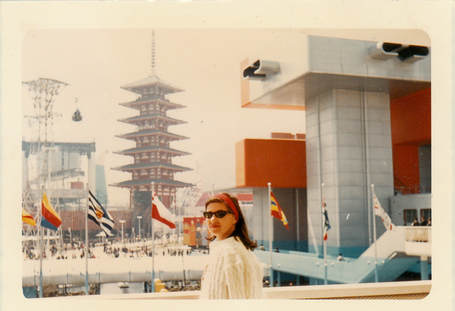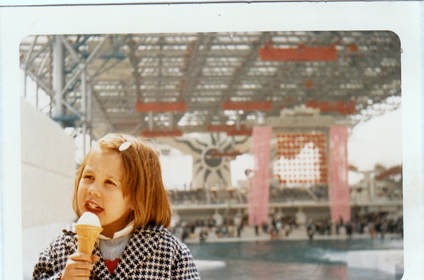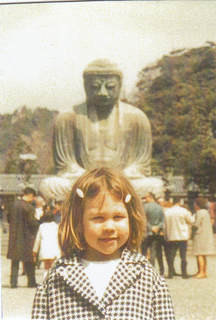 Sherrill at Expo 70, Osaka Japan
Sherrill at Expo 70, Osaka Japan Sometimes, as I explore this maze of memories from so many decades ago, I'm not entirely sure of the order in which events happened—or even where. Did we talk with the group of visiting Spanish students at Mr. Aso or at Beppu? Was it Kyoto where I had to go back for my camera? Or Nara? And Monkey Mountain? Did we actually go there or did I just read about it? It's bad enough when today I can't remember what room I left my eyeglasses in, but forget our past? After all, it's our past that makes us who we are.
These days, I can look up facts and even pictures on the internet, but that doesn't truly address these questions. Where? Here or there? When? How? Really? Mostly, I think, the memories return and organize themselves properly, but can I sure?
So where are we, now? Still in Japan, I think, on our way to the world's fair.
A busy day of traveling reminded us again that Japan is a collection of peaks thrust from the bottom of the sea, many of them still alive with volcanic energy. By ferry and bus we crossed bays and bridges between maybe a dozen of those islands and then finally climbed into the mountains until we reached our next hotel near the top of Mt. Aso, the world's largest active volcanic crater. From the hotel, we could walk to the rim of the bubbling caldera and a view down hundreds of feet to a green lake shooting gaseous steam and boiling mud into the air. The few people we saw hiking closer had covered their noses and mouths.
Sherrill always wanted to see a volcano erupt, but it didn't seem to be happening there, only that churning and spitting. And how close would we want to be to the action, anyway? The mountain-top hotel we stayed in on that trip closed long ago. Recent photos on the internet show the remains of rotting buildings in a jungle of steam and giant weeds. By contrast, the ryokan we stayed in the next day at Beppu, another hot springs spa, has flourished.
"We're sleeping on the floor?"
Simone gazed down at the low futons in our ryokan room.
"It'll be fun," I promised. Hoped.
She pounded one of the firmly-stuffed cylinders at the ends of our futons.
"A Japanese pillow," I explained.
Built over scores of hot springs continually puffing billows of steam, the town of Beppu seemed to float among gray-white clouds pierced here and there by pine trees. Sherrill took Simone to the women's spa in our hotel and I tried the spa for men, bigger than I expected, with pools of varying size and temperature. Those days we spent among forested mountains, hot springs, and slumbering volcanoes were a nice change from the exciting, crowded Japanese cities we'd visited earlier. Soon, we'd be on the way to quite different adventures, including Osaka and Expo 70.
"Look!" Simone pointed to one of the large whirlpools that appeared from time to time, shades of blue and green and foamy white, revolving faster and faster around each other, as if trying to suck a passing boat to the blurry depths.
A Japanese boy about Simone's age and his mother sat near us in the lounge, opposite the doors that opened to the deck. He and Simone eyed each other, then slipped into a mostly wordless game. Sherrill and I smiled at the boy's mother, she offered us a modest smile in return. Somehow, the two children communicated enough to spend a contented half hour or more together. After a while, the boy's mother took him away, maybe to lunch. Before long, we went in search of food, too, and eventually down to our room.
We napped, waking to see hundreds of bright lights in the growing darkness, many scattered over huge cranes and others decorating massive ships. The spectacle went on and on, until we fell asleep again. Later, we realized that it had to have been Kobe, then the world's busiest container port. When we woke again, we were docking at Osaka.
At last, later that morning, we bused to Expo 70, billed as the biggest exposition the world had ever seen. Seventy-seven countries were represented, so we knew we'd never see more than part of it, even with the two full days we had there. We wandered through a huge Japanese garden that traced the history of Japanese garden styles. By now, you may have noticed a recurring theme in these memories: Sherrill's love of gardens and gardening. Sherrill and Simone particularly enjoyed Singapore's pavilion, its traditional-style building set in its own garden that featured a lake, tropical birds, turtles, even alligators. Although most pavilions were ultra modern, several others for countries Sherrill and I would visit a decade or two later—including Laos, Cambodia, Thailand, and Vietnam—were built primarily in their traditional architectural styles, emphasizing the natural over the futuristic.
Lunch that first day took us into the air. We were given a box lunch as we stepped into a closed-in gondola in a new kind of Ferris wheel and rose into the sky, where we could see all of Expo and had time to enjoy both the food and the view. The expo grounds were so huge, we used the monorail and moving walks to help us get around. We couldn't decide if it was significant that the Soviet pavilion soared upward, while the U.S. pavilion hugged the ground with its low translucent dome. We made a point of visiting the Japanese Folk Crafts museum and Sumitomo's pavilion of fairy tales of the world. The Scandinavian pavilion was ahead of its time with a warning about the impact of global pollution.
Starting with the first great exhibitions in London, New York, and Paris, the emphasis was on material progress, inventions, the advancing industrial age changing the ways in which people would live. Each exposition sought to dazzle visitors with new technology more than the previous one had. Expo 70, as I remember it, seemed to have a rather different goal. Instead of featuring an Eiffel Tower, giant gun, or rocket ship, it displayed a more humanistic approach with its wide-eyed Tower of the Sun in the central festival plaza, a stylized, friendly, almost cuddly figure. The most important nod to the triumph of science that we saw at the fair was the U. S. display of moon rocks brought back by Apollo 12 the year before.
I suspect that few experiences can color our vision of the future as forcefully as a world's fair. Walking past Expo 70's pavilions and wandering through some of them (after standing in lines, in many cases), examining exhibits and gathering souvenirs, did provoke new ideas and suggest new destinations for future travels and experiences. Why not go to these places? Why not discover Southeast Asia, the Middle East, even places we'd never heard of?
The world is out there, so explore it.
To be continued....


 RSS Feed
RSS Feed